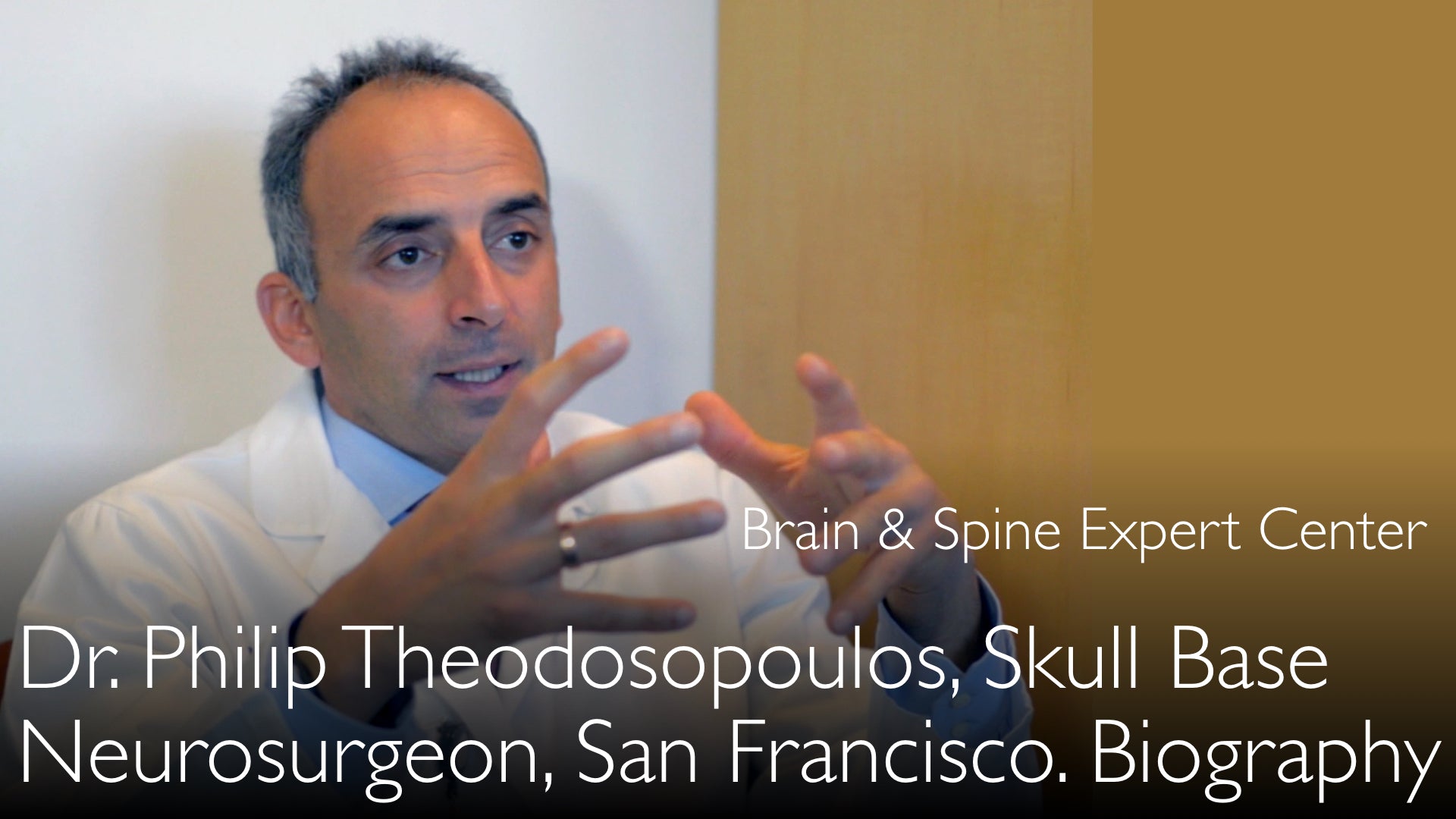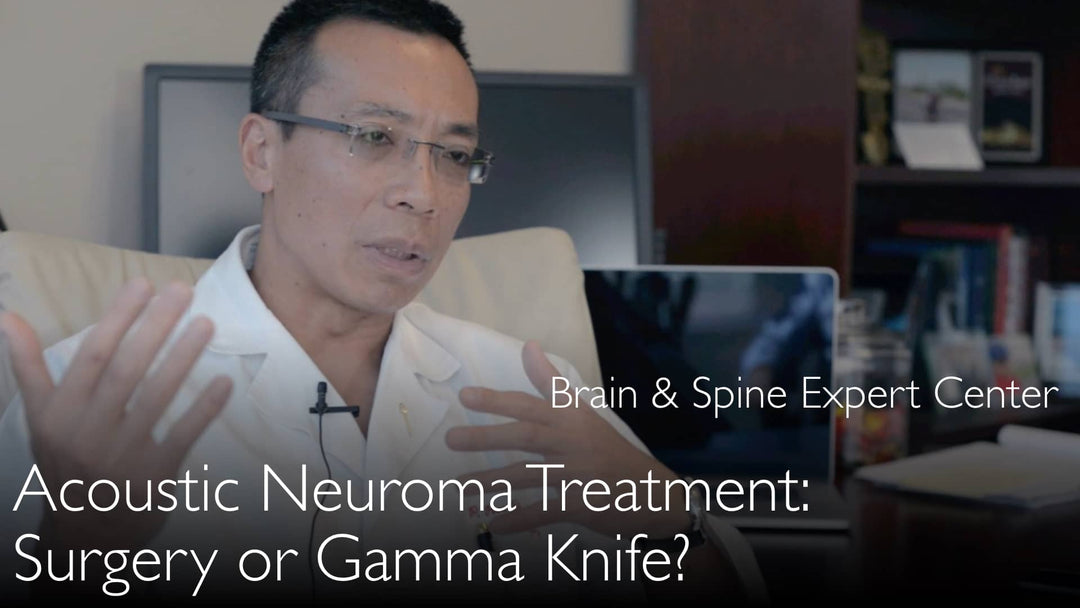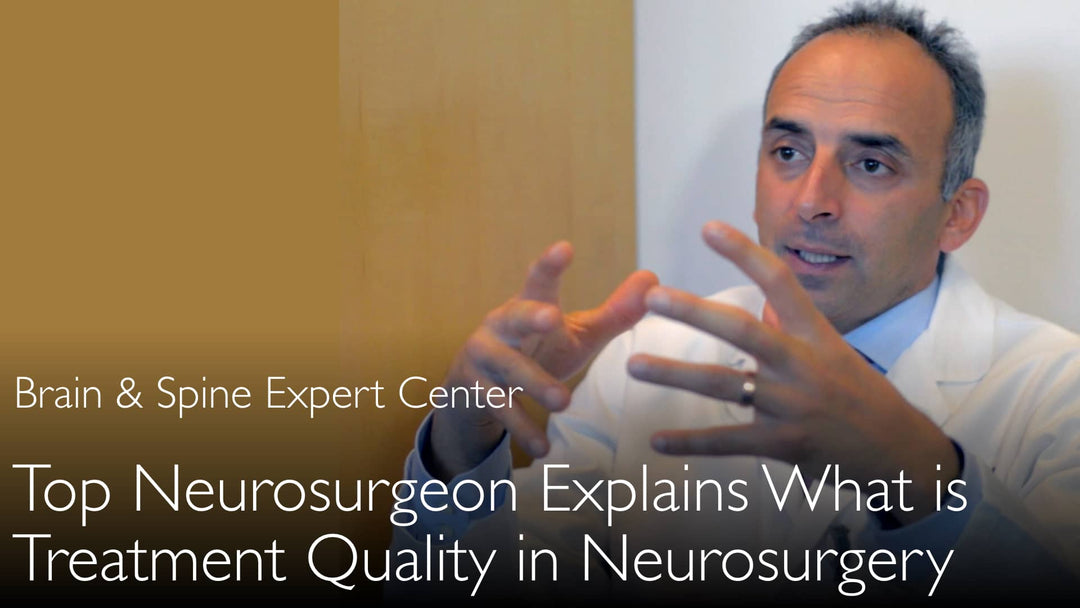Johtava vähäinvasiivisen neurokirurgian asiantuntija, tohtori Philip Theodosopoulos, MD, selittää endoskopisen kallonpohjatumorin hoidon kehityksen. Hän kuvailee, kuinka uudet tekniikat mahdollistavat syvien aivokasvainten saavuttamisen nenän kautta ilman ulkoisia leikkauksia. Tämä lähestymistapa pyrkii vähentämään aivojen siirtoa ja leikkausperäisiä komplikaatioita. Tohtori Philip Theodosopoulos, MD, käsittelee innovaation ja todistetun tehon tasapainoa monimutkaisessa aivokasvainleikkauksessa.
Edistynyt vähäinvasiivinen endoskooppinen aivokasvainleikkaus kallonpohjassa
Hyppää osioon
- Kallonpohjaleikkauksen haasteet
- Sädehoidon vaikutus hoitoon
- Endoskooppinen nenäkäytävä
- Uusi teknologia ja työkalut
- Hoidon indikaatioiden määrittely
- Leikkaustekniikoiden vertailu
- Koko transkriptio
Kallonpohjaleikkauksen haasteet
Lääketieteen tohtori Philip Theodosopoulos korostaa kallonpohjaneurokirurgian erityisiä vaikeuksia. Aivot ja niiden kriittiset verisuonirakenteet ovat tiheässä järjestyksessä liikkumattoman kallon sisällä. Perinteiset avoleikkausmenetelmät syvällä keskellä sijaitseviin kasvaimiin vaativat usein merkittävää aivojen siirtelyä. Tämä siirtely voi aiheuttaa vakavaa aivokudoksen vaurioitumista.
Kirurgien on historiallisesti jouduttu tuhoamaan suuria määriä kallonpohjan luusta ja alla olevaa pehmytkudosta päästäkseen näihin leesioihin. Tohtori Theodosopoulos vahvistaa, että nämä laajat tekniikat pysyvät monimutkaisten kasvainten kulta-standardina. Päämääränä on aina kasvaimen täydellinen poisto, ei vain leikkaushaavan koon minimointi.
Sädehoidon vaikutus hoitoon
Sädeleikkauksen kehittäminen oli merkittävä tekijä kallonpohjakirurgian vähäinvasiivisemmaksi tekemisessä. Teknologiat kuten Gamma Knife toimittavat tarkkoja, tietokoneohjattuja sädesäteitä. Tämä mahdollistaa lääkäreiden hoitaa tiettyjä aivokasvaimia ilman minkäänlaista leikkausta.
Lääketieteen tohtori Philip Theodosopoulos huomauttaa tämän luoneen paradigman muutoksen. Ala siirtyi suurista, rummuuttavista leikkauksista ei-invasiiviseen vaihtoehtoon. Tämä edistys pakotti neurokirurgit uudelleenarvioimaan, kuinka he voisivat suorittaa omia toimenpiteitään vähäinvasiivisemmin pysyäkseen relevantteina.
Endoskooppinen nenäkäytävä
Nykyaikainen vähäinvasiivinen neurokirurgia kallonpohjalle on usein "leikkaushaavaton" toimenpide. Kirurgit pääsevät aivojen syvimpiin osiin nenän ja luontaisten sivuonteloiden kautta. Tämä lähestymistapa tunkeutuu kalloon sen pohjalta ilman ulkoisia leikkauksia kasvoilla tai päässä.
Lääketieteen tohtori Philip Theodosopoulos selittää, että tämä menetelmä hyödyntää endoskooppeja mikroskopojen sijaan. Nämä pitkät teleskoopit tarjoavat panoraamanäyn leikkausalueen syvistä osista. Kirurgit voivat porata ja poistaa luuta päästäkseen kallon keskelle, vähentäen lähestymistapaan liittyvää sairastuvuutta dramaattisesti.
Uusi teknologia ja työkalut
Siirtyminen endoskooppisiin käytäviin edellyttää täysin uutta erikoistyökalujen sarjaa. Nämä uudet reitit ovat pieniä, kapeita ja tehokkaita, mutta esittävät ainutlaatuisia haasteita. Kirurgien on operoitava 15–20 senttimetrin päästä sisäänmenokohdasta, mikä vaatii edistyneitä taitoja ja työkaluja.
Lääketieteen tohtori Philip Theodosopoulos korostaa, että teknologia on vain osa yhtälöä. Todellinen haaste on kehittää asiantuntemus näiden työkalujen turvalliseen ja tehokkaaseen käyttöön. Tämä uusi teknologia pyrkii tarjoamaan paremman pääsyn kasvaimiin samalla kun vähäistetään terveen aivokudoksen oheisvaurioita.
Hoidon indikaatioiden määrittely
Kriittinen kysymys nykyneurokirurgiassa on määrittää, mitkä kasvaimet sopivat parhaiten endoskooppisille tekniikoille. Huipputason tutkimus keskittyy näiden vähäinvasiivisten lähestymistapojen todellisten indikaatioiden määrittelyyn. Tutkimus keskittyy siihen, tarjoavatko nämä menetelmät saman kasvaimenpoistotehokkuuden kuin perinteinen leikkaus.
Tohtori Theodosopoulos huomauttaa, että vaikka vähäinvasiivisempi leikkaus vaikuttaa intuitiivisesti paremmalta, näin ei aina ole. Ala työskentelee aktiivisesti määrittääkseen, missä hyödyn ja riskin raja kulkee. Tavoitteena on varmistaa, että vähäinvasiivisempi lähestymistapa ei vaaranna potilaan parantamisen päätavoitetta.
Leikkaustekniikoiden vertailu
Vähäinvasiivinen kirurgia ei rajoudu endoskooppisiin menetelmiin. Tohtori Theodosopoulos selventää, että avokallonleikkaus on myös kehittynyt vähäinvasiivisemmaksi. Kirurgit tekevät nykyään pienempiä leikkauksia, kuten kulmakarvaleikkauksia, joista syntyy paljon pienempiä avauksia päähän kuin aiemmin.
Nämä hienostuneet avotekniikat toimivat tärkeänä vaihtoehtona puhtaasti endoskooppisille lähestymistavoille. Päätös endoskooppisen toimenpiteen ja vähäinvasiivisen avokraniotomian välillä on monimutkainen. Lääketieteen tohtori Anton Titov ja lääketieteen tohtori Philip Theodosopoulos ovat samaa mieltä, että paras lähestymistapa räätälöidään kasvaimen ja potilaan anatomialle.
Koko transkriptio
Lääketieteen tohtori Anton Titov: Vähäinvasiiviset tekniikat ovat vahva trendi nykyaikaisessa kirurgiassa eri alaspesialiteeteissa. Endoskooppinen ja vähäinvasiivinen neurokirurgia on yksi keskeisistä painopisteistäsi.
Minulla oli erittäin mielenkiintoinen keskustelu Bostonissa sydänkirurgian professorin, tohtori Lawrence Cohnin kanssa. Keskustelimme vähäinvasiivisista tekniikoista sydänkirurgiassa ja sydänkirurgian trendeistä, jotka keskittyvät vähäinvasiiviseen kirurgiaan.
Neurokirurgiaa tehdään erittäin rajoitetussa tilassa. Aivot ja niiden ympärillä olevat verisuoni- ja tukirakenteet ovat tiheässä järjestyksessä kallon sisällä. Vähäinvasiivisten tekniikoiden soveltaminen neurokirurgiassa on siis erittäin vaikeaa, mutta samalla erittäin tarpeellista.
Voisitko puhua joistakin esimerkeistä, joissa sovellat vähäinvasiivisiä kirurgisia ja endoskooppisia tekniikoita neurokirurgiassa? Mitä tuloksia havaitset?
Lääketieteen tohtori Philip Theodosopoulos: Olen täysin samaa mieltä kanssasi. Tämä on ollut trendi nykyaikaisessa kirurgiassa pitkään. Itse asiassa se on ollut trendi kirurgiassa yleisesti. Se ei ole vain trendi nykyaikaisessa kirurgiassa, vaan ehdottomasti viimeisen vuosikymmenen ajan.
Neurokirurgiassa olimme hieman myöhässä pääsemässä vähäinvasiivisiin hoitomenetelmiin. Osittain syynä on juuri se, mitä sanoit. Kallo on rajoitettu tila. Meillä on jo suhteellisen pieniä leikkausalueen avauksia. Jopa suurimmat avauksemme ovat pieniä verrattuna mihin tahansa muihin leikkauksiin, joita teemme kehossa.
Pienempien lähestymistapojen ja leikkausten käyttöperusteet ovat luonnollisesti hyvin yhteneväiset minkä tahansa muun anatomisen alueen perustelujen kanssa. Vaikka neurokirurgian potilaiden oireet suuremmista aivokasvainleikkauksista eivät ole täsmälleen samat kuin muissa kehon osissa tehtävistä lähestymistavoista.
Sydän- ja vatsakirurgia hyötyvät pienistä leikkauksista ja endoskooppisista porteista suurien leikkausten sijaan lähinnä vähemmän postoperatiivisen kivun vuoksi. Mutta aivoissa kyse on paljon enemmästä.
Aivoissa, erityisesti kallonpohjalla, vähäinvasiiviset leikkaustekniikat ovat erilaisia. Kallonpohjalle pääseminen on erittäin vaikeaa. Kun ajattelet kallonpohjaa, jos asetat keskipisteen molempien puolien väliin, se on todella kallonpohjan keskusta.
Kallonpohja on hyvin syvä. Se sijaitsee paljon aivojen ja kriittisten aivorakenteiden alapuolella. Ne ovat liikkumattomia. Jotkut aivorakenteet ovat liikkuvia aivovaurion kustannuksella.
Kun lähestymme näitä leesioita kallon keskustassa, päädymme tuhoamaan paljon aivokudosta. Voimme välttää aivojen siirtelyn, aivorakenteiden siirtelyn, joka maksaa aivovaurion hinnan. Joten tuhoamme paljon itse kallonpohjan luustoa.
Tuhoamme paljon kallonpohjan alla olevaa pehmytkudosta. Toisinaan vahingoittaisimme myös aivoja päästäksään näihin paikkoihin. Nämä tekniikat pysyvät silti kulta-standardina. Koska kyse ei ole siitä, että olisi nätti. Kyse on kasvainten poistamisesta.
Aivokasvainleikkausta ei ole helppo tehdä. Sitä ei voi tehdä puolittain. Leikkausalueen on oltava riittävän avoin. Mutta vähäinvasiivisen endoskooppisen aivokasvainhoidon idea syntyi.
Alamme kallonpohjakirurgiassa saavutti tämän pisteen. Maksimoimme kallonpohja-alueella aiheuttamamme sairastuvuuden päästäksemme aivokasvaimeen. Eikä se ollut hyvä. Vaikka pystyimme tekemään paljon vähentääksemme kasvaimen ympärillä aiheutuvaa sairastuvuutta tai ongelmia.
Nykyaikanamme todellinen vauhti kallonpohjaneurokirurgian vähäinvasiivisemmaksi tekemisessä on sädeleikkaus. Ihmiset ovat kuulleet gamma veitsestä. Se on yksi koneista, jotka käyttävät keskitettyjä tietokoneohjattuja sädesäteitä.
Sädeleikkaus oli siis merkittävä tekijä kallonpohjakasvainten neurokirurgian vähäinvasiivisemmaksi tulemisessa. Koska yhtäkkiä pystyit mahdollisesti vaikuttamaan näihin kallonpohjan aivokasvaimiin. Lääkärit pystyivät tehokkaasti hoitamaan aivokasvaimia ilman minkäänlaista leikkausta.
Joten yhtäkkiä siirrymme suurista rummuuttavista leikkauksista vaihtoehtoiseen aivokasvainhoitoon, jossa ei ole leikkausta. Pysyäksemme muiden kirurgisten hoitomuotojen trendin mukana, meidän piti ajatella kovasti. Kuinka voimme tehdä kallonpohjan aivokasvainleikkausta vähäinvasiivisemmin?
Tässä vaiheessa vähäinvasiivinen neurokirurgia kallonpohjalla on "leikkaushaavaton" neurokirurgia. Se tarkoittaa nenän kautta kulkemista. Kuljemme nenän ympärillä olevien ja nenän takana olevien luontaisten sivuonteloiden kautta.
Yritämme päästä kalloon sen pohjalta itsestään. Mutta pääsemme kallonpohjalle leikkaamatta minkäänlaista kohtaa kasvoilla tai päässä. Joten leikkaushaavoja ei tehdä lainkaan. Menet nenän kautta, pääst aivojen keskustaan.
Kyllä, leikkaushaavoja ei tehdä lainkaan. Tehdäksemme tämän nyt, meillä on vain erilainen teknologia kuin se, johon olimme tottuneet. Olimme tottuneet työskentelemään mikroskoopin kanssa, mikä vaikeuttaa leikkausalueen visualisointia kallonpohjakasvainten hoidossa.
Joten käytämme endoskooppeja. Nämä ovat pitkiä teleskooppeja, jotka voimme asettaa nenään. Sitten meillä on panoraamanäky syvältä sisältä. Voimme porata luun, voimme poistaa luun. Yhtäkkiä olemme kallon keskellä leikkaamatta mitään.
Vähäinvasiivinen endoskooppinen kallonpohjakasvainten hoitomenetelmä tulee erillisellä hinnalla. Koska nämä käytävät kallonpohjakasvaimeen eivät ole kovin suuria ja avaria. Yleensä käytävät, joilla pääsemme kallonpohjakasvaimeen ylhäältä, olivat aina suuria ja avaria. Siksi sairastuvuus oli korkea.
Nykyään nämä käytävät kallonpohjakasvaimeen ovat pieniä, kapeita, tehokkaita. Mutta tarvitaan kokonaan uusi instrumenttisto. Meidän on pystyttävä pääsemään kallonpohjakasvaimeen ja turvallisesti tekemään mitä teimme ennen.
Koska yhtäkkiä nyt operoit 15 tai 20 senttimetrin päästä aloituskohdastasi. Uudet työkalut uudelle teknologialle! Uudet työkalut uudelle teknologialle.
Ja todella missä olemme tänään on tässä. Huipputason tila on, että emme vielä täysin tiedä, mitkä aivokasvaimet sopivat näille uusille vähäinvasiivisille tekniikoille. Kuinka paljon kokemusta tarvitset ollaksesi turvallinen käyttäessäsi näitä uusia tekniikoita?
Joten olemme kaikki pyrkimässä uudelleenmäärittelemään tai määrittelemään ensimmäistä kertaa, mitkä ovat todelliset indikaatiot vähäinvasiiviselle endoskooppiselle lähestymistavalle kallonpohjakasvaimiin. Meillä on leikkaustekniikka, joka on vähemmän invasiivinen. Se on endoskooppinen neurokirurgia.
Se voi antaa saman tuloksen kasvaimen poistotehokkuuden tai hoidettavan sairauden hoidon suhteen. Endoskooppinen kallonpohjakasvainhoito aiheuttaa myös vähemmän sairastuvuutta suoraan kasvaimen poistosta. Endoskooppinen neurokirurgia aiheuttaa vähemmän sairastuvuutta leikkaustekniikasta.
Vaikka kaikista tuntuisi intuitiiviselta, että pienen leikkausavauksen pitäisi aiheuttaa vähemmän komplikaatioita, alhaisempi sairastuvuus, näin ei aina ole. Tästä syystä nykytutkimus keskittyy minimi-invasiivisen kallopohjatumorien hoidon kehittämiseen.
Tämä on erittäin tärkeää. On selvää, että uusia työkaluja kehitetään uusille tekniikoille ja niitä sovelletaan. Tämä tarkoittaa potilailla vähemmän komplikaatioita. Se mahdollistaa paremman pääsyn ja paremman hoidon kohdistetulle kallopohjatumorille.
Lääketieteen tohtori Anton Titov: Mielestäni tämä on yleisesti hyväksytty perusoletus, johon moni asia perustuu. Olemme me ja muut tutkijat osoittaneet, että minimi-invasiivisen menetelmän etu kallopohjatumorien hoidossa pätee tietyille kasvaimille. On kuitenkin myös totta, että emme ole täysin varmoja, missä raja leikkauksen hyödyn ja riskien välillä kulkee.
Lääketieteen tohtori Philip Theodosopoulos: Meidän on verrattava minimi-invasiivista ja endoskopista hoitoa joihinkin aivokirurgisiin toimenpiteisiin, jotka on parempi tehdä avoimella leikkauksella. Puhumme paljon endoskopisesta minimi-invasiivisesta aivokirurgiasta.
Mutta minimi-invasiivinen kirurgia on myös sitä, mihin avoin aivokirurgia on kehittynyt. Ennen teimme suuria leikkausavauksia, suuria aukkoja päähän. Nyt teemme pienen leikkausavauksen kulmakarvanalueelle ja pieniä aukkoja päähän.
Lääketieteen tohtori Anton Titov: Joten tämä on vaihtoehto kaikille näille endoskopisille lähestymistavoille.








